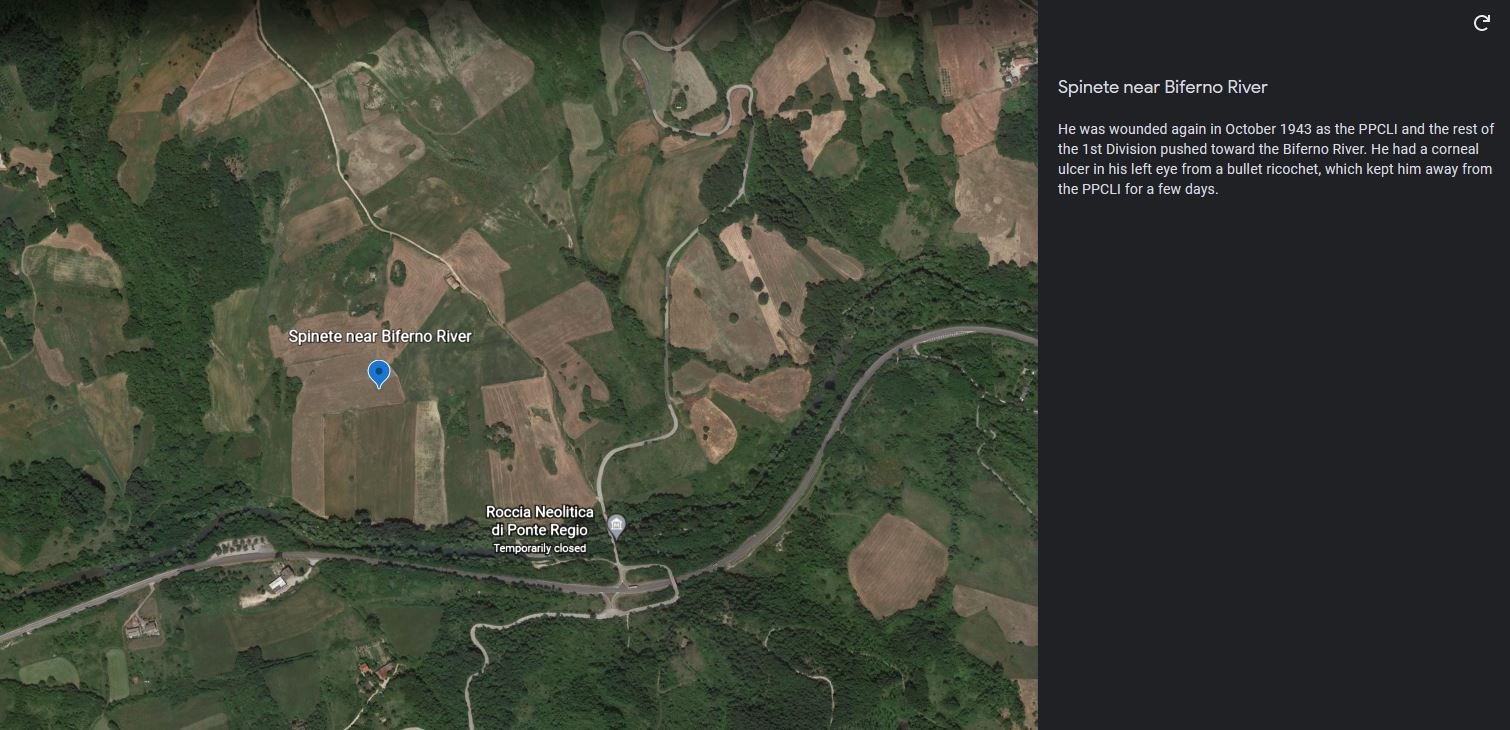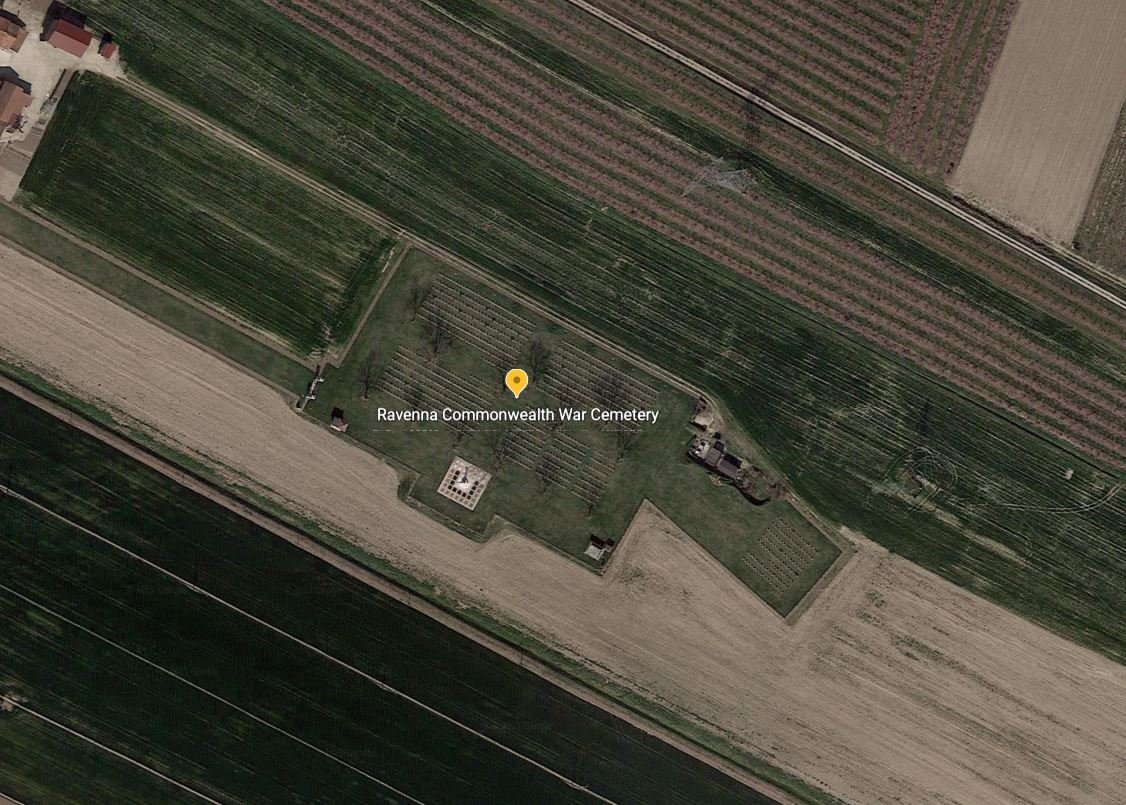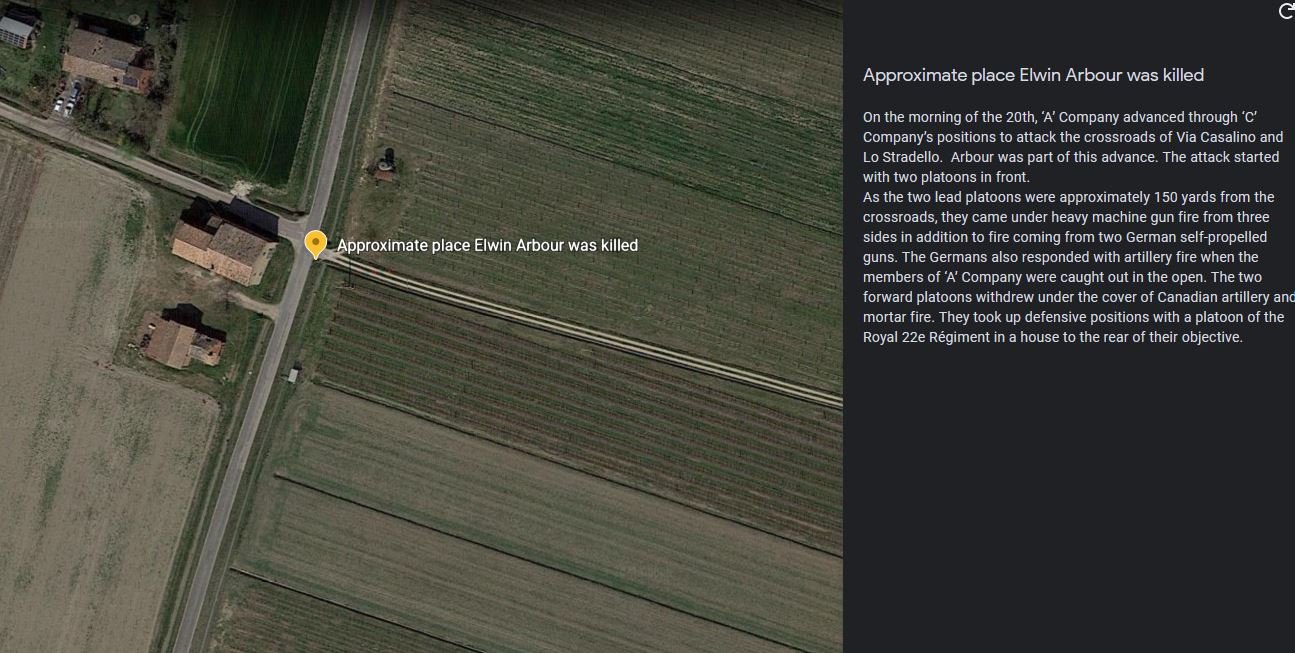Following the footsteps of Sgt Elwin Arbour
Following the footsteps of Sgt Elwin Arbour
In early 2021, our team was asked to help research the story of Sergeant Elwin Arbour of the Princess Patricia’s Canadian Light Infantry (PPCLI).
Elwin Abour’s initial pay book
Elwin Glen Arbour was born in Tay, Ontario, near Lake Simcoe, on the 2nd of July 1915. His parents were Harry and Elizabeth Arbour. Only his father was alive at the time of his death. He was the seventh child out of ten. Elwin played many sports including boxing, baseball, skating, and skiing.
Arbour enlisted on the 19th of September 1939 with the Princess Patricia’s Canadian Light Infantry (PPCLI) in Winnipeg, Manitoba.
He listed his address as 94 ½ Scollard Street Toronto, Ontario, and recorded his job as “Labourer” after having worked in logging camps, driving a caterpillar tractor, and various other construction jobs.
He listed “Single” as his marital status. His sister, Lila Arbour, was listed as his next of kin.
As to why this was the case, a note from Lila stated that she was the only family member he was in contact with for many years, “Due to reasons that are personal.” He was assigned the Regimental Number H/16217. He was part of ‘A’ Company throughout his military service.
He departed Canada with the PPCLI from Halifax on the 21st of December 1939. He arrived at Greenock, Scotland on the 30th of December 1939. During his time in the United Kingdom, Arbour rose through the ranks. He was promoted to Lance Corporal on the 27th of May 1940. He was made a full Corporal on the 21st of February 1942 and promoted to Acting Sergeant on the 1st of August 1942.
During his time in the United Kingdom, Arbour rose through the ranks.
Promoted to Lance Corporal on the 27th of May 1940.
Promoted to full Corporal on the 21st of February 1942.
Promoted to Acting Sergeant on the 1st of August 1942.
The Allies landed on Sicily on the 10th of July 1943. Arbour was with the PPCLI as they fought their way across the island. On the 29th of July, as ‘A’ Company of the PPCLI sat in defensive positions near Agira, Arbour was wounded, possibly by German mortars, by shrapnel, which injured his back. He was removed from the line that day and he rejoined the PPCLI on the 3rd of August 1943.
“Before meeting the team at Project ’44, I had little knowledge of my ancestors involvement in World War II. Though I knew my great uncle died fighting overseas, I had no idea where to start when it came to researching his story. Project ‘44’s team were able to give my family an almost step by step account from the time he landed in Europe to his death in Italy. Reading the research package was actually quite emotional for our family. If you have a love one who fought in WWII I highly recommend engaging the Project ‘44 team.”
– Linley McConnell (niece of elwin arbour)
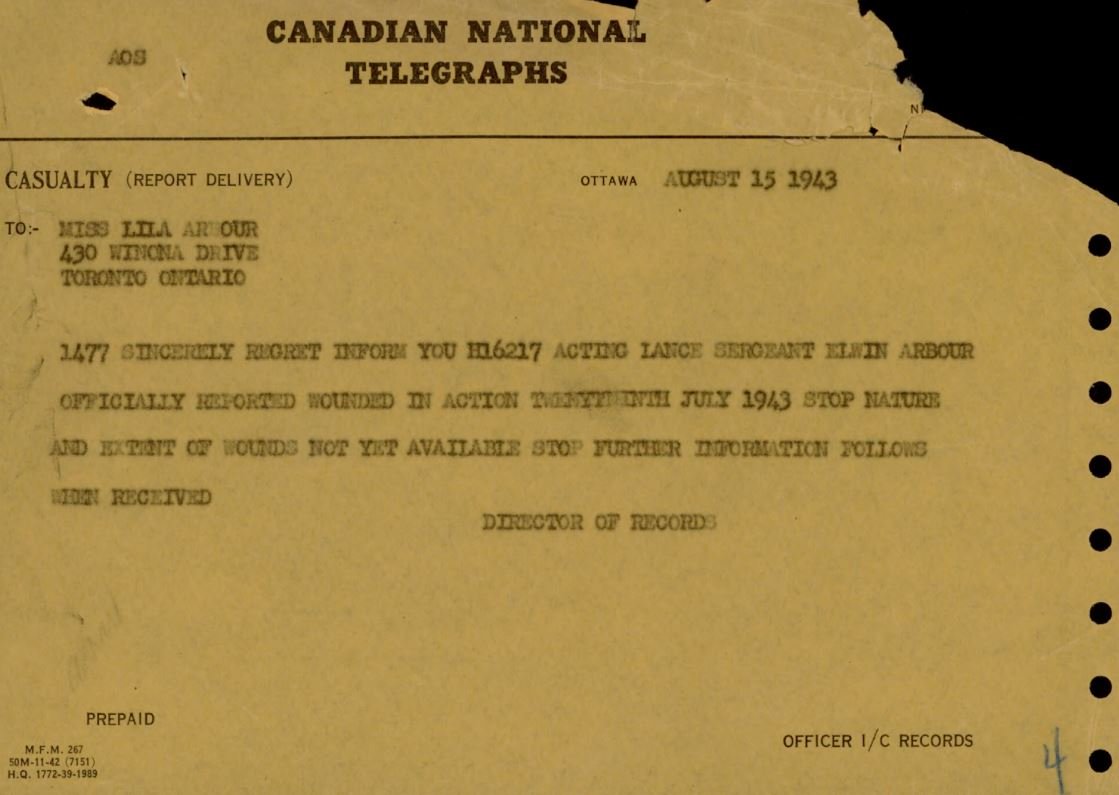
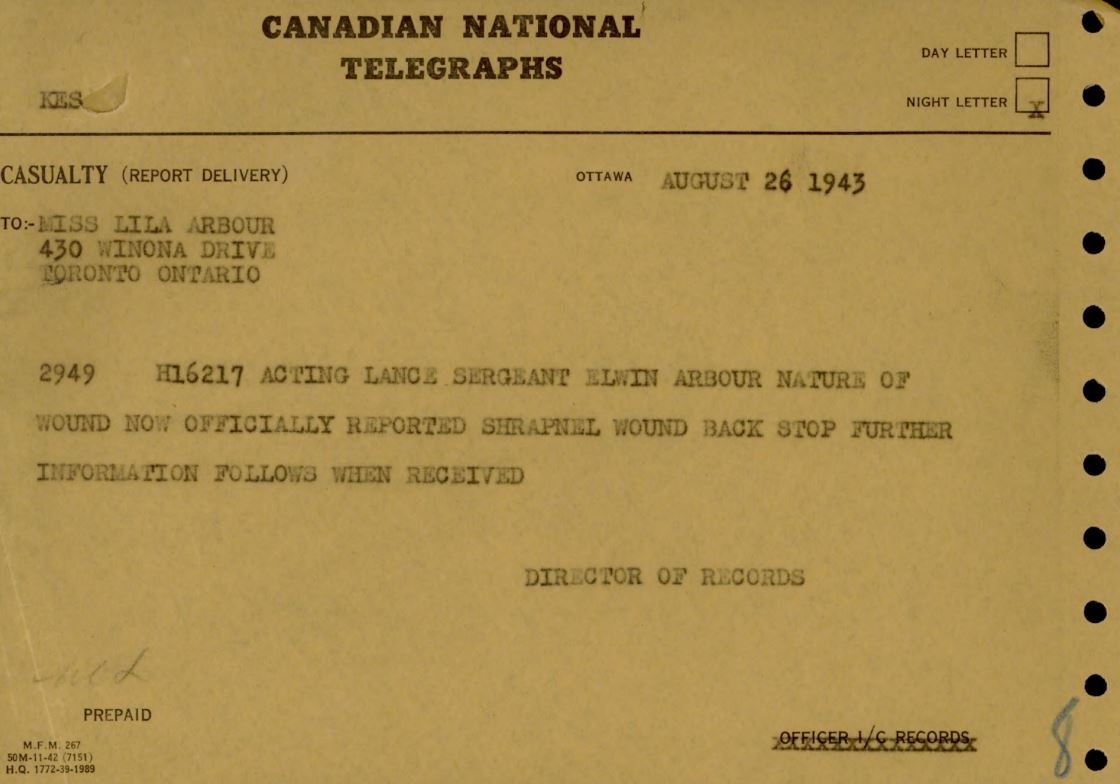
He was wounded again in October 1943 as the PPCLI and the rest of the 1st Division pushed toward the Biferno River. He had a corneal ulcer in his left eye from a bullet ricochet, which kept him away from the PPCLI for a few days.
He was made a full Sergeant on the 2nd of November 1943, the rank which he held until his death.
Arbour had one unexplained absence from the PPCLI. It took place throughout the summer and autumn of 1944. He was listed as being part of the 8th Battalion 2nd Canadian Base Reinforcement Depot as of the 29th of June 1944. This unit was a Non-Effective Transit Wing, which meant he was awaiting transfer back to his unit. He returned to the PPCLI by the 9th of December 1944.
By December 1944, the 1st Canadian Infantry Division, a military unit made up of several brigades, was advancing toward Ravenna, on Italy’s Adriatic coast, as the Allies pushed the Germans further north. The 2nd Brigade, a formation made up of several battalions, which included PPCLI , was tasked with cutting off the town of Bagnacavallo, west of Ravenna. They were to assault between the bend in the Fosso Munio and the bridgehead which the 3rd Brigade was holding west of the Naviglio Canal.
“During this action we had five men killed, ten wounded, two missing...”
The attack began on the 19th with ‘C’ Company of the PPCLI advancing in a southwesterly direction along the Via Pozzarda and, despite some strong German machine gun fire, they captured the junction where that road meets the Via Guarno. They held these positions overnight.
On the morning of the 20th, ‘A’ Company advanced through ‘C’ Company’s positions to attack the crossroads of Via Casalino and Lo Stradello. Arbour was part of this advance. The attack started with two platoons in front.
As the two lead platoons were approximately 150 yards from the crossroads, they came under heavy machine gun fire from three sides in addition to fire coming from two German self-propelled guns. The Germans also responded with artillery fire when the members of ‘A’ Company were caught out in the open. The two forward platoons withdrew under the cover of Canadian artillery and mortar fire. They took up defensive positions with a platoon of the Royal 22e Régiment in a house to the rear of their objective.
Map showing Bagnacavallo with the area of the attack shown north circled in red. Map is from
“Growing up, my parents told me we had a relative who fought in World War II, and though we did some research, it was complicated to piece together. Project ‘44’s research package provided us with an in depth and chronological account of Elwin Arbour’s journey. My son is around the same age Elwin was when he passed away fighting overseas. Project ’44’s work put things into perspective. This is impactful and important work as it ensures the accounts of Canadian soldiers are not forgotten.”
– Rob McConnell
After this attack failed, engineers cleared the roads of mines which allowed Canadian armour to move forward. Another PPCLI attack, this time undertaken by ‘D’ Company and supported by armour, went forward but it too failed.
By the evening, enough mines had been removed that more tanks and support weapons could be brought forward to support the advance and the Loyal Edmonton Regiment cleared the PPCLI’s flank. ‘A’ Company attacked again and before midnight they had captured positions along the Lo Stradello road.
Arbour was initially buried at the 2nd Canadian Infantry Brigade Cemetery near Bagnacavallo, near where he was killed.
He was later buried, as Canadian policy was to group as many graves together as possible, in the Ravenna War Cemetery. He rests in Plot 6, Row D, Grave 30.
After his death, $2407.51, from a War Service Gratuity payment, the reminder of Elwin’s pay and allowances, and victory bond purchases made by Elwin, was sent to his sister.
His personal effects, of which he carried when he died, were also sent to his sister.
Research package on Sgt Elwin Arbour:
Google Earth presentation on Sgt Elwin Arbour:
Project ‘44 - Historical Research
Dr Brad St Croix
Our Project ‘44 team has teamed up with Dr. Brad St Croix from “On This Day in Canadian Military History” to deliver historical research on the Second World War.
Combining Project ‘44’s extensive collection of documents, war diaries and mapping technology with Dr St Croix’s historical research, our team can deliver an in depth report on your relative.





